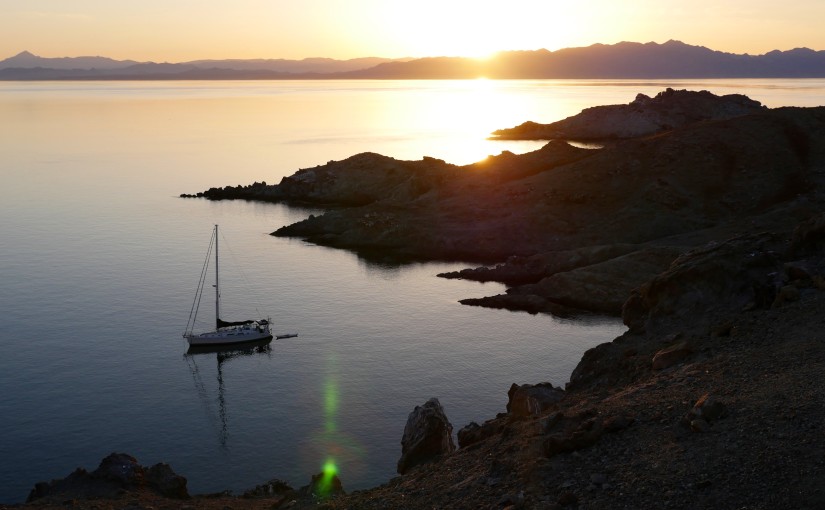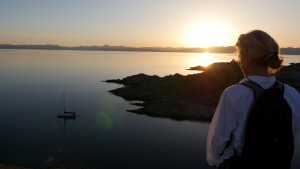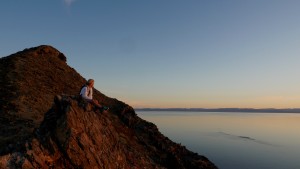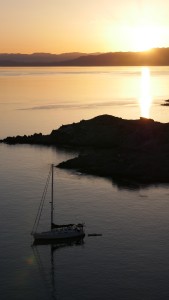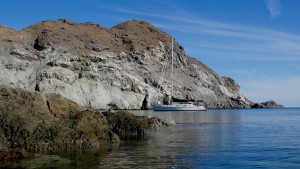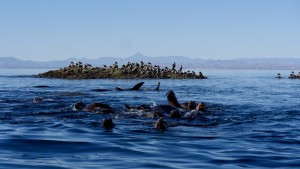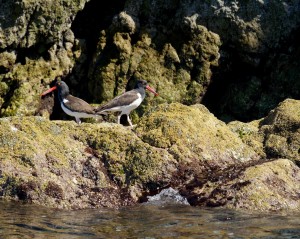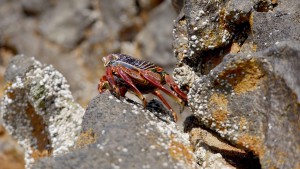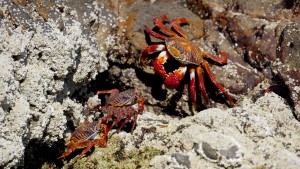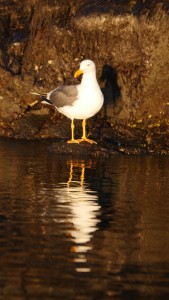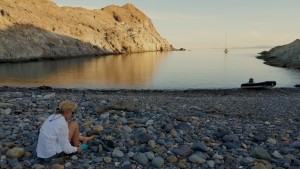Fishing Report, February 27 2016
Isla Salsipuedes. (Leave if You Can)
With coffee just ready we had the morning SSB weather report tuned in, listening to the preamble of sailboats underway checking in, when our neighbor at the anchorage, tucked around the rocky point from us came over with his wife in their fishing skiff. In terms of size and industrial heft this would put any Florida flats boat to shame. Their boat, named (not coincidentally) Salsipuedes, is a Selene trawler. Diana mistook them as local fishermen at first due to their quiver of fishing poles, and in a sense they were. They said they’d been coming to this area for fifteen years. Turns out they are from Great Falls Montana, retired ranchers or farmers. He reminded us a bit of Chum (our former Springhill neighbor), very friendly, good sense of humor, with lots to say. They had Sally, their very polite dog, some kind of brown poodle on board. I snuck in as many fishing questions into the general howdy-do palather as I thought I could get away with. Enough to make an impression. They went ashore so the dog could have a little land break, then showed up a while later and invited me to go fishing with them. Diana stayed because she was in the middle of making some killer zucchini bread (as she does). I got my lesson in how to jig the bottom for golden spotted bass and accompanying species. Exactly the kind of thing I had read about and never really figured out. Not complicated, but with its own subtleties. Brian likes catching, so being able to release fish was an important consideration. He had his iron jigs set up with a single hook, not trebles, up at the top of the lure. His poles were set up with nice small reels (easy to handle) with spectra line. Jigging: drop the line, controlling the free spool with the thumb of your left hand with your right hand ready on the drag to click it on the moment the lure hits bottom and then ready on the reel handle because it seems like the fish hit the lure almost immediately settles. Half a turn on the handle and then jig it along as you drift bouncing off the bottom. So simple, fishing authors take for granted that you’ve known how to do it since you were five. Strikes sometimes feel like the jerk of the heavy jig against the line.
Brian hooked up on his very first drop as I was still trying to figure out how to get my bucktail jig on my spinning outfit to drop, and then how to tell it was on bottom. He reeled in a nice golden, a “three-taco” (3-4 pounds I’d guess). I was still flailing when he caught a one-taco on his next drop. I think he had released four fish before I finally managed by accident to do something right and hook a one-taco golden. Not sure if he registered that I’d actually managed to overcome my ignorance and actually catch something, but he then suggested I use one of his rods. This lure was a little heavier than his, so he warned me to be careful about not lingering on the bottom as I would probably get hung up. Mastering the order of events, from guiding the drop to setting the drag on and getting the jig jigging, took a little but it was a whole different deal than trying to do it with the spin outfit (in that it actually made sense). I caught another one-taco, as Brian caught a few more and then things slowed down. Throughout he was talking pretty much non-stop, so that if there actually was a moment of silence, it really did feel like something was sort of wrong. Lynn did not say a word, Brian spoke for her. “She” used to love fishing, and was really good at it, had caught a 200 pound Tuna once and then sorta quit, cuz how do you top that? She nodded.
I’m sure it was as obvious to them as it was to us that we each represented two different “Montana” types and an age-old cultural divide. On one side you have those farmer/rancher/miner types who would never ask the question “am I an authentic Montanan?” On the other you have the gentleman farmer, not-a-rancher-or-miner type, outdoors enthusiasts I guess, who populate places like Bozeman and Missoula, who are aware of the question of authenticity in everything. We feel the need to mention our bonafides, twenty-five years in Montana, so that we do not appear to be, what we so definitely self-identify as, namely “newcomers.” We’re newcomers to Baja, of course, too, and sailing, and as was brilliantly obvious, jigging. In some way, we are culturally condemned to always be newcomers. Perhaps we would do better to adopt the label, nomads, which conjures figures like Geronimo more than the college educated city-slickers we are commonly identified with. Montana friends who know our actual history well enough to know better, still think of us as Californians even though for me, that period represents less than 15% of my life. I don’t know what Californians think of us as, but they can definitely tell, that nomads like us don’t belong there either. I guess the reason I’m sensitive to all of this is my own Eastern Washingon/Idaho family who have always represented a cultural alter ego — me worrying that they think I’m some liberal cityslicker and them worrying that I write them off as redneck hicks. The truth of course is some kind of hybrid for all of us, along a spectrum, but newly meeting fellow “Montanans” we naturally look for the things we have in common. Fishing and a passion for remote places seemed to provide the intersection.
They dropped me off, and then offered (with some slightly un-subtle hinting from us) to sell us some gasoline since we’d forgotten to fill up the jerry can before leaving Santa Rosalia. We got a tour of Saslipuedes, a look at the “dark side” of powerboating. Spacious means extra space you have and don’t even have to use.
In the afternoon I went fishing on my own, armed with new information and actual training. The jigs I had bought (based on nothing but my total ignorance and the willingness of tackle shop owners to sell you anything) had treble hooks and were a size too big (#6). I cut the hooks down to one and went out to try my luck. Brian had a fishfinder with a seven inch screen and gps for marking his spots on his fishing skiff. I had a handheld depthfinder, which actually turned out to be very useful at finding a drop off and water that wasn’t too deep or too shallow. The current over the reef south of our anchorage was running like a river. You could actually see it welling up and boiling around the rock pinnacles. I came upon one just under the surface which was downright scary and quickly turned away. It took a little bit to get my Penn reel to spool off nicely on the drop and it was hard to feel the hit on the bottom (at first), but I fished for a couple of hours and managed to catch one two-taco golden and about four one-tacos as well as two Triggerfish. I kept the two-taco and a one-taco I couldn’t release because I had caught him in too deep water and his buoyancy bladder had blown up on the too rapid ascent. I also kept one of the triggerfish to see how it was to eat. They are such odd looking fish (to a trout fisherman), and it boggles me that a fish with a mouth that small would go after a lure that’s five inches long. We are feeling much more comfortable with eating reef fish after Diana asked Brian who’d been fishing here for 15 years about ciguatera and he’d said, “cigua-what?” with that particular, northern drawl of an eastern Montanan.
